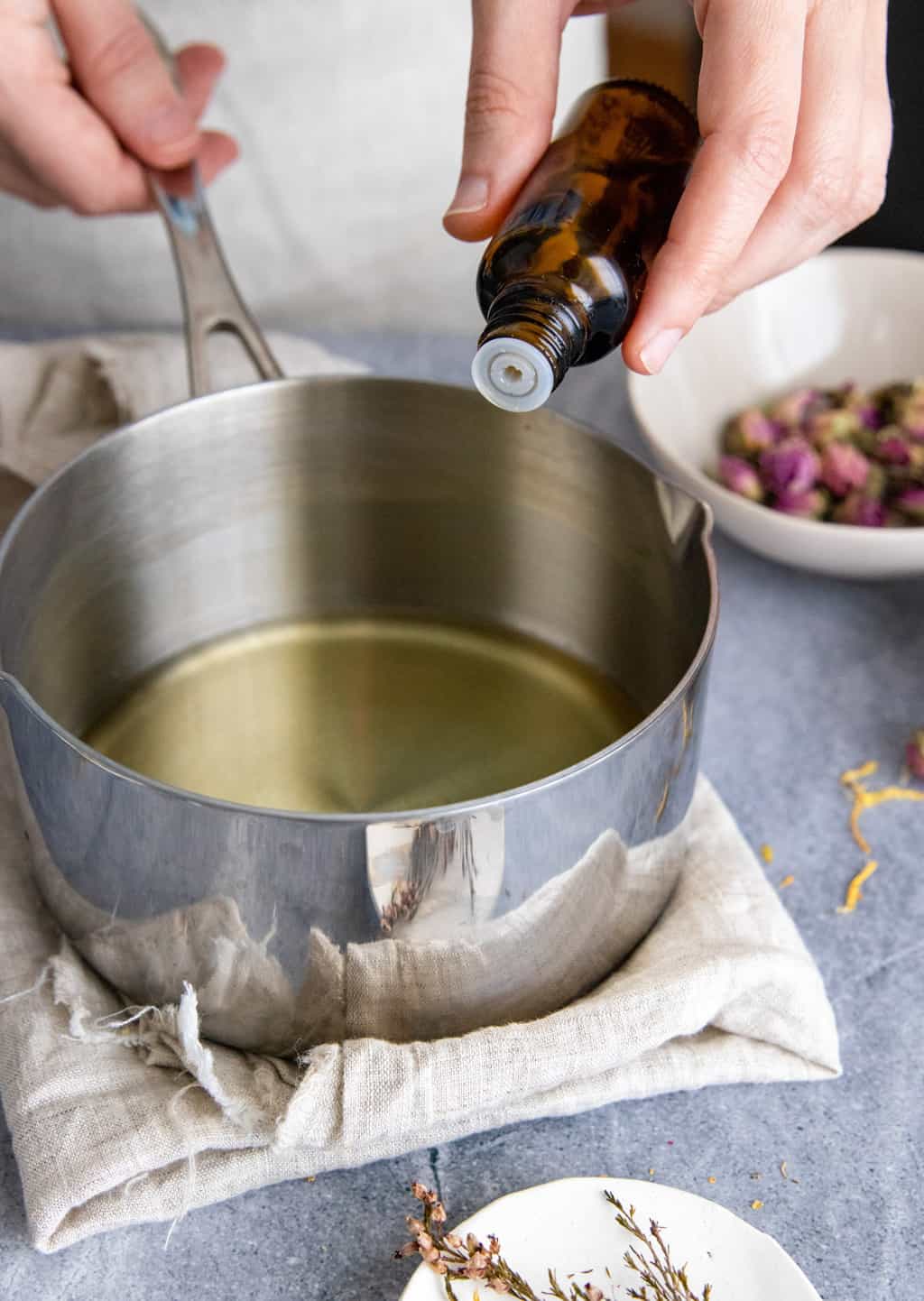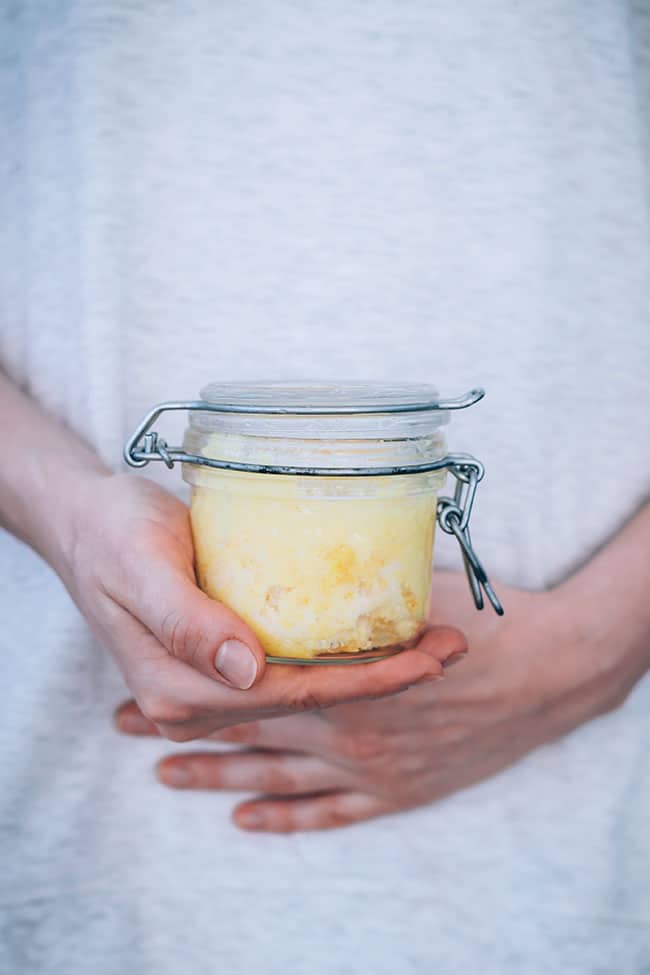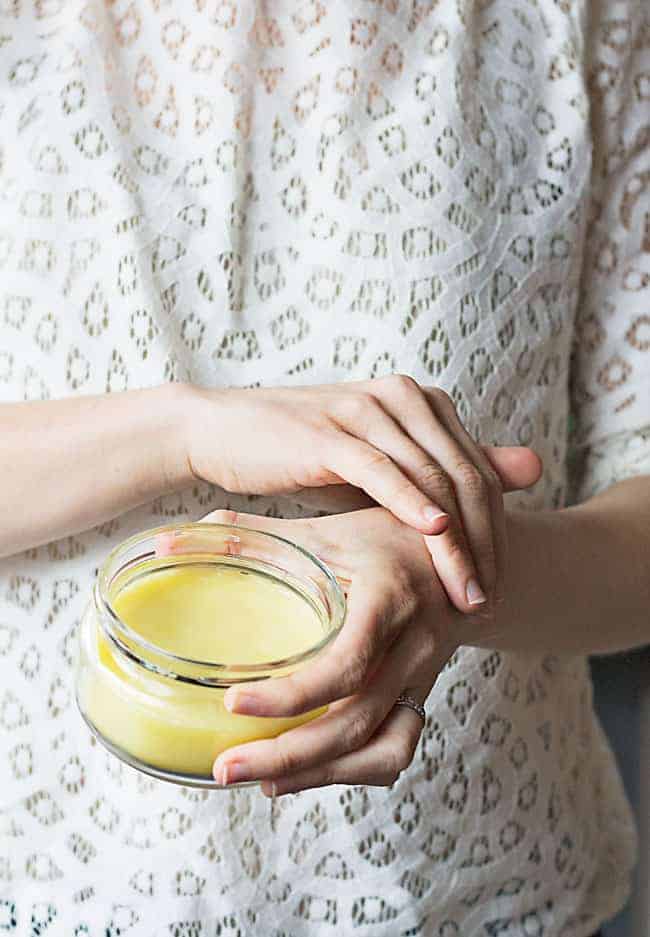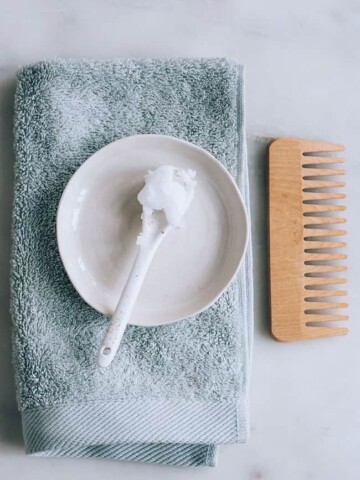From headaches to cracked heels—so, literally, head to toe—herbal salves are a game-changer. And we promise they’re really easy to make, just as long as you’re patient enough for your herbs to dry and oils to infuse.
From there on, the possibilities are endless! Read more about the dos and don’ts of herbal balms here, and have a look at some of the best balm and salve recipes we’ve found.
How to Make Herbal Salves
An herbal salve is essentially a soothing ointment that’s infused with the healing properties of flowers and herbs.
While the term “herbal salve” often calls to mind the image of a witchy woman hovering over a large pot of herbs, in truth, salves are anything but complicated (or even witchy, for that matter). Heck, you don’t even need a giant cauldron or lots of equipment. Just a jar, herbs, oil, and wax are all that’s required for making your own medicinal balm at home.
You do, however, need some patience. Because herbs are finicky, you don’t want to expose them to tons of heat or you may damage the nutrients that make them so healing. To get the most oomph from your herbs, I recommend infusing them slowly over the course of several weeks rather than simmering them on the stove. Yes, it does take longer, but it’s worth it. Promise.
Step 1: Choose your herbs.
You can use any herbs you like—fresh or dried—in your herbal salve. I prefer dried herbs because they’re easier to find, especially when it comes to more medicinal herbs, and they’re less likely to mold or release water during the infusion process. But if you only have access to fresh herbs, then use what you’ve got.
Here are some of the best herbs for herbal salves:
—Chamomile
—Rosemary
—Thyme
—Echinacea
—Peppermint
—Plantain
—Cayenne
—Cinnamon
—Lavender
—Rose petals
—Arnica
—Calendula
—Lemon balm
—Comfrey
—Eucalyptus
My favorite source for dried herbs is Mountain Rose Herbs. You can find bulk herbs at your local health food store or on Amazon, too. Just make sure to look for organic food-grade herbs from a brand you trust (Frontier Co-op is a good one, but there are lots of others).
Step 2: Infuse your oil.
Before crafting your own herbal salve, you’ll first need to infuse your oil.
Gather:
—8-ounce glass jar with lid
—Dried or fresh herbs (enough to fill the jar roughly ⅔ of the way)
—Approx. 6 ounces carrier oil, such as sweet almond, grapeseed, olive, or jojoba
Fill your jar roughly ⅔ of the way with dried herbs. It doesn’t have to be exact, and you definitely don’t need to measure or weigh anything. Just eyeball it.
Next, cover the herbs with the carrier oil of your choosing. Just make sure it’s shelf-stable and won’t go rancid if left to sit out.
I use sweet almond or olive oil, but you can use anything you have on hand. Ideally, you should avoid coconut oil as it tends to solidify at room temperature. And you want to make sure there’s at least 1 inch of oil covering the top of the herbs.
Replace the lid and give it a gentle shake to coat the herbs evenly. Then place the jar on a bright but not sunny windowsill, and let the herbs infuse for 2 to 3 weeks, shaking daily.
If the herbs absorb too much oil, simply add more. And if you notice any mold forming on top of your herbs, skim it off and keep going. Mold is more likely to occur with fresh herbs, but it’s not totally unheard of with dried.
Once the oil is done infusing, strain out the herbs using cheesecloth or a fine mesh strainer. Some herbs leave a gritty sediment in the oil. If this bothers you, strain the oil twice, once with cheesecloth and once with a coffee filter.
Store in an airtight jar away from heat and sunlight.
Note: If you would prefer to use heat to infuse your oil more quickly, simply place the herbs and oil in a small saucepan and simmer on low (preferably between 100°F and 140°F) for 3 to 4 hours, or until the oil has taken on the scent and color of the herbs. Let the oil cool to room temperature before straining the herbs and making your salve.
Step 3: Make your salve.
Now, let’s focus on the salve itself.
You’ll need:
—2 tablespoons (1 ounce) beeswax pastilles (or carnauba wax if you’re vegan)
—1 tablespoon (½ ounce) shea butter (optional, but gives your salve a creamier consistency)
—½ cup (4 ounces) herb-infused oil
—Essential oils - the number of will depend on the dilution you want to achieve. For 2% dilution, use 12-18 drops per ounce. This recipe has 5 ounces (not including the optional shea butter) so that would be 60-90 drops of essential oil.
—8-ounce glass jar
—Saucepan or double boiler
Start by placing the beeswax and shea butter in a small saucepan or double boiler. (I’m a rebel, so I just put mine directly in the saucepan. If you’d prefer to use a double boiler, go for it.)
Heat on very low heat, stirring regularly until just melted.
Once completely melted, remove from the heat and add your herb-infused oil and essential oils. Stir to mix everything together.
Pour the melted salve into a clean, dry container and let it sit overnight to firm up. Keep the finished product in a cool, dry location and it should last for about a year.
Use your salve to soothe skin, heal wounds, or whatever would benefit from your particular herbal salve.
Herbal Salve FAQs
Will my herbal salve go rancid? Do I need to use a preservative?
All oils will eventually go rancid, especially if exposed to sunlight or heat. I recommend storing your salve in a cool, dark place and using it within 6 months. You’re free to add 1–3 teaspoons of vitamin E oil to your salve to help prolong its shelf life.
Do I need to sterilize my container before pouring in the salve?
Yes, always use a sterilized container for herbal remedies to keep bacteria at bay. To sterilize your container, wipe it down with rubbing alcohol and let it dry. You can also boil heat-proof glass containers in water for 10 minutes.
Can I infuse carrier oil with herbal powders?
Yes, ground herbs and powders can be used to infuse your carrier oil. Just note that you may have a harder time straining them from the oil mixture, and they may make your salve a little gritty.
Can I add herbal extracts when making salve?
Since salves are oil-based, I don’t recommend using extracts since they’re predominantly water or alcohol-based. They may separate or not blend properly.
13 Homemade Herbal Balm + Salve Recipes
1. DIY Hormone-Balancing PMS Balm
Soothe irritability and discomfort during PMS week with this Hormone-Balancing PMS Balm that uses raspberry leaf, evening primrose oil, and peppermint essential oil.
2. Homemade Healing Eczema Balm
This one utilizes the best essential oils for eczema, plus a healing balm made with raw honey, essential oils, and shea butter.
3. Make Your Own Egyptian Magic
We’ll show you how to make your own Egyptian Magic, our favorite skin salve for eczema, breakouts, healing, and more. Made from a combination of olive oil, raw honey, beeswax, bee pollen, royal jelly, and bee propolis, it really is magic!
4. DIY Essential Oil Breathe Easy Balm
Colds and allergies can make every breath you take feel uncomfortable. Relieve congestion with this DIY Breathe Easy Balm made with our favorite essential oils for congestion and respiratory ailments. It also includes a recipe that’s safe for use with children.
5. Peppermint Headache Balm
To relieve headaches, use a combination of dried peppermint leaves and lavender flowers [source], which will keep for quite a while if stored properly.
6. DIY Activated Charcoal Salve Recipe
Use this Activated Charcoal Black Salve recipe to make a powerful remedy that relieves bug bites and stings and even draws out splinters.
7. DIY Antibacterial Salve Recipe
Use this DIY Antibacterial Salve recipe infused with lavender [source], calendula [source], and tea tree [source] essential oils as your go-to first aid treatment for minor scrapes or cuts.
8. Rich Honey Hand Balm
Winter can be brutal on your hands. If you’re suffering from dryness, painful cracks, and redness, this homemade Honey Hand Balm will help. We also swear by this Kokum Butter Balm for repairing flaky skin and cracked cuticles.
9. DIY Warming Muscle Rub
This DIY Warming Muscle Rub is made with a blend of cayenne pepper [source] and ginger [source] that soothes post-workout soreness and other aches and pains. It’s a skin-warming combination of almond oil, shea butter, coconut oil, beeswax, ground cayenne pepper, ground ginger, and camphor, peppermint, clove, and eucalyptus essential oils.
10. Bug Bite Balm Sticks
Try this soothing combination of coconut oil, shea butter, and essential oils to make Bug Bite Balm Sticks that will soothe itchy bites all summer long. It includes lemon balm [source] and other oils that calm inflammation and kill bacteria.
11. After-Sun Body Balm
Cocoa butter is chock full of essential fatty acids [source], so it hydrates the skin deeply and locks in moisture to keep skin soft and supple. For a full-body cocoa butter balm, try this After-Sun Butter to rejuvenate parched, dry skin. Or combine it with coconut oil to make an easy cuticle balm that smells like a vacation in a jar.
12. Green Tea Zinc Oxide Balm
Because it is infused with green tea and zinc oxide, this balm protects your lips from free radicals [source] and sun damage [source]. Did you know zinc oxide makes a great acne balm, too? Add it to a balm to heal wounds, regenerate cells, and reduce inflammation—all of which work well for fighting acne.
13. Lavender Heel Balm
Our heels take a beating, often causing chapped and cracked areas. A heel balm is a great solution for this common problem. Lavender is both antiseptic and anti-inflammatory [source]. Plus, this calming, relaxing herb helps bring on sleep [source] when used in a pre-bedtime foot massage.
This post was medically reviewed by Dr. Rina Mary Allawh, M.D., a dermatologist who practices adult and pediatric medical dermatology, skin cancer treatment, and cosmetic dermatology. Learn more about Hello Glow’s medical reviewers here. As always, this is not personal medical advice, and we recommend that you talk with your doctor.
136

























